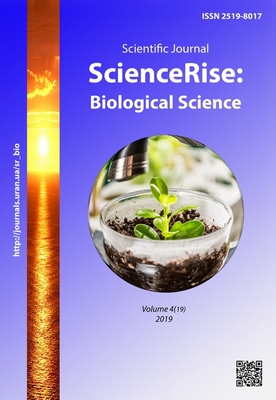Optimization of the relation of ω-6 / ω-3 fatty acids in sunflower oil
DOI:
https://doi.org/10.15587/2519-8025.2019.189139Keywords:
fatty acids, blend, gas chromatography, polyunsaturated fatty acids ω-3 and ω-6, linoleic and linolenic acidAbstract
According to the modern theory of nutrition, food must not only meet the physiological needs of man, but also have therapeutic and prophylactic properties. The disadvantage of sunflower oil is the practical absence of linolenic acid, which is attributed to the group of polyunsaturated fatty acids ω-3 (vitamin F), in its fatty acid composition The enrichment of sunflower oil with linolenic acid transforms it into a product of prophylactic and therapeutic purpose, increasing the number of its functional properties.
Purpose of the study: to obtain model mixtures with the optimum ratio of unsaturated fatty acids.
Materials and methods: blending method, high-performance gas chromatography method.
Results: The fatty acid composition of the obtained fat mixtures was investigated and the ratio of ω-3 / ω-6 polyunsaturated higher carboxylic acids was established, which justifies the use of 90:10 sunflower oil flax blends for daily nutrition and 70:30 for prophylaxis.
Conclusions: The results obtained can be used to improve the ratio of higher carboxylic acids ω-3 and ω-6 in the diet, which can have a positive effect on the dynamics of cardiovascular disease. Oil mixtures with a balanced fatty acid composition can become an effective tool for the prevention of cardiovascular diseases and increase the functionality of products of the oil and fat industry
References
- Gebauer, S. K., Psota, T. L., Harris, W. S., Kris-Etherton, P. M. (2006). n−3 Fatty acid dietary recommendations and food sources to achieve essentiality and cardiovascular benefits. The American Journal of Clinical Nutrition, 83 (6), 1526S–1535S. doi: http://doi.org/10.1093/ajcn/83.6.1526s
- Pro zatverdzhennia naboriv produktiv kharchuvannia, naboriv neprodovolchykh tovariv ta naboriv posluh dlia osnovnykh sotsialnykh i demohrafichnykh hrup naselennia (2016). Postanova Kabinetu Ministriv Ukrainy No. 780. 11.10.2016. Available at: https://zakon.rada.gov.ua/laws/show/780-2016-%D0%BF
- Zhohlo, F. A. (2002). Nevodni rozchynnyky. Kharakterystyka, vlastyvosti ta zastosuvannia v tekhnolohii hotovykh likarskykh form. Lviv: Afisha, 80.
- DSTU 4492:2005. Oliia soniashnykova. Tekhnichni umovy (2006). Kyiv: Derzhspozhyvstandart Ukrainy, 22.
- Gladyshev, M. I. (2012). Nezamenimye polinenasyschennye zhirnye kisloty i ikh pischevye istochniki dlia cheloveka. Jornal of Siberian Federal Univesity. Biology, 4 (9), 1920–1935.
- Simopoulos, A. P. (2000). Human Requirement for N-3 Polyunsaturated Fatty Acids. Poultry Science, 79 (7), 961–970. doi: http://doi.org/10.1093/ps/79.7.961
- Matvieieva, T. V. (2014). Kupazhi olii – dzherelo polinenasychenykh zhyrnykh kyslot. Odeska natsionalna akademiia kharchovykh tekhnolohii, 46 (2), 210–213.
- Iankovskaia, L. V., Kezhun, L. V., Slobodskaia, N. S., Belous, Iu. I., Morgunova, E. M. (2016). Vliianie palmovogo masla na risk razvitiia serdechno-sosudistykh zabolevanii. Zhurnal Grodnenskogo gosudarstvennogo medicinskogo universiteta, 4 (56), 6–11.
- GOST 30623-98. Masla rastitelnye i margarinovaia produkciia. Metody obnaruzheniia falsifikacii (1998). Moscow: Izd-vo standartov, 16.
- Metodicheskie rekomendacii MR 2.3.1.1915 – 04. Rekomenduemye urovni potrebleniia pischevykh i biologicheski aktivnykh veschestv (2004). Moscow, 45.
- Pereira, H., Barreira, L., Figueiredo, F., Custódio, L., Vizetto-Duarte, C., Polo, C. et. al. (2012). Polyunsaturated Fatty Acids of Marine Macroalgae: Potential for Nutritional and Pharmaceutical Applications. Marine Drugs, 10 (12), 1920–1935. doi: http://doi.org/10.3390/md10091920
Downloads
Published
How to Cite
Issue
Section
License
Copyright (c) 2019 Yyriy Osyp, Maria Osyp, Oksana Rakovets

This work is licensed under a Creative Commons Attribution 4.0 International License.
Our journal abides by the Creative Commons CC BY copyright rights and permissions for open access journals.
Authors, who are published in this journal, agree to the following conditions:
1. The authors reserve the right to authorship of the work and pass the first publication right of this work to the journal under the terms of a Creative Commons CC BY, which allows others to freely distribute the published research with the obligatory reference to the authors of the original work and the first publication of the work in this journal.
2. The authors have the right to conclude separate supplement agreements that relate to non-exclusive work distribution in the form in which it has been published by the journal (for example, to upload the work to the online storage of the journal or publish it as part of a monograph), provided that the reference to the first publication of the work in this journal is included.









